The future of risk is clear:
- there’s going to be more of it
- it’s going to come at us with greater speed and intensity
- unless we are watching really carefully, we won’t be aware of it until we have to deal with it
- the implications of not dealing with new risks will become more severe as time moves on
- it’s not the known risk that will get us – it’s the unknown risk that matters
- there is more new unknown risk coming at us
- it’s coming at us even faster than we know
- and in that context, that means there are a lot of new risks that are yet to come that we don’t yet understand and that we don’t yet know how to manage
And in 2023, a key trend that leaders and organizations must manage is the rapid emergence of new risks and escalating risk realities!
Isn’t that depressing? It shouldn’t be if you use this reality as the basis for an action plan going forward. That’s trend #4 of my ‘23 Trends for 2023‘ to watch.
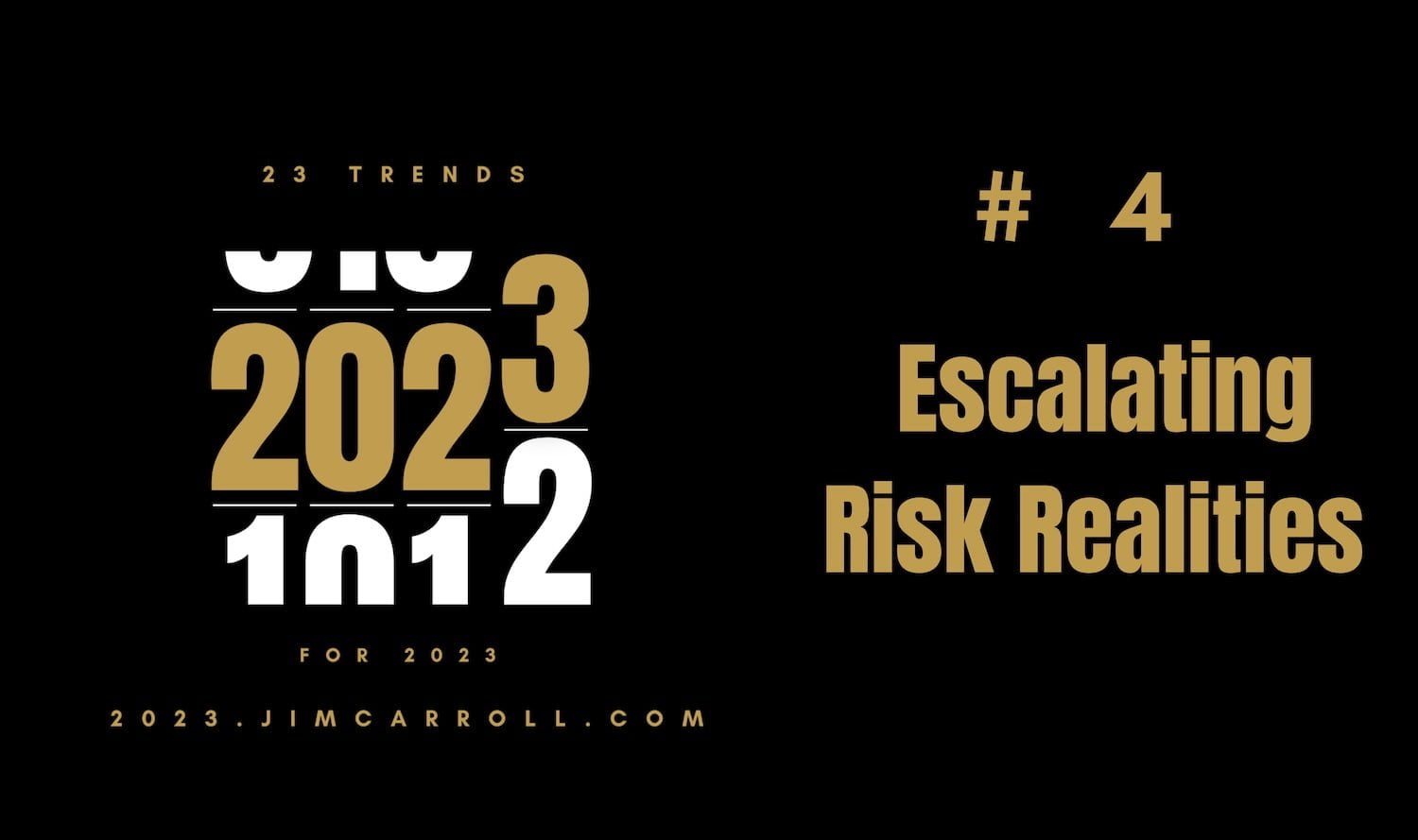
Think about the context of the future of risk in the context of this quote which I often talk about on stage:
“Companies that do not yet exist will build products that are not yet conceived, based on ideas that have yet been generated, using materials not yet invented, with manufacturing methods that have not yet been conceived. Are you ready for the new world of disruption?”
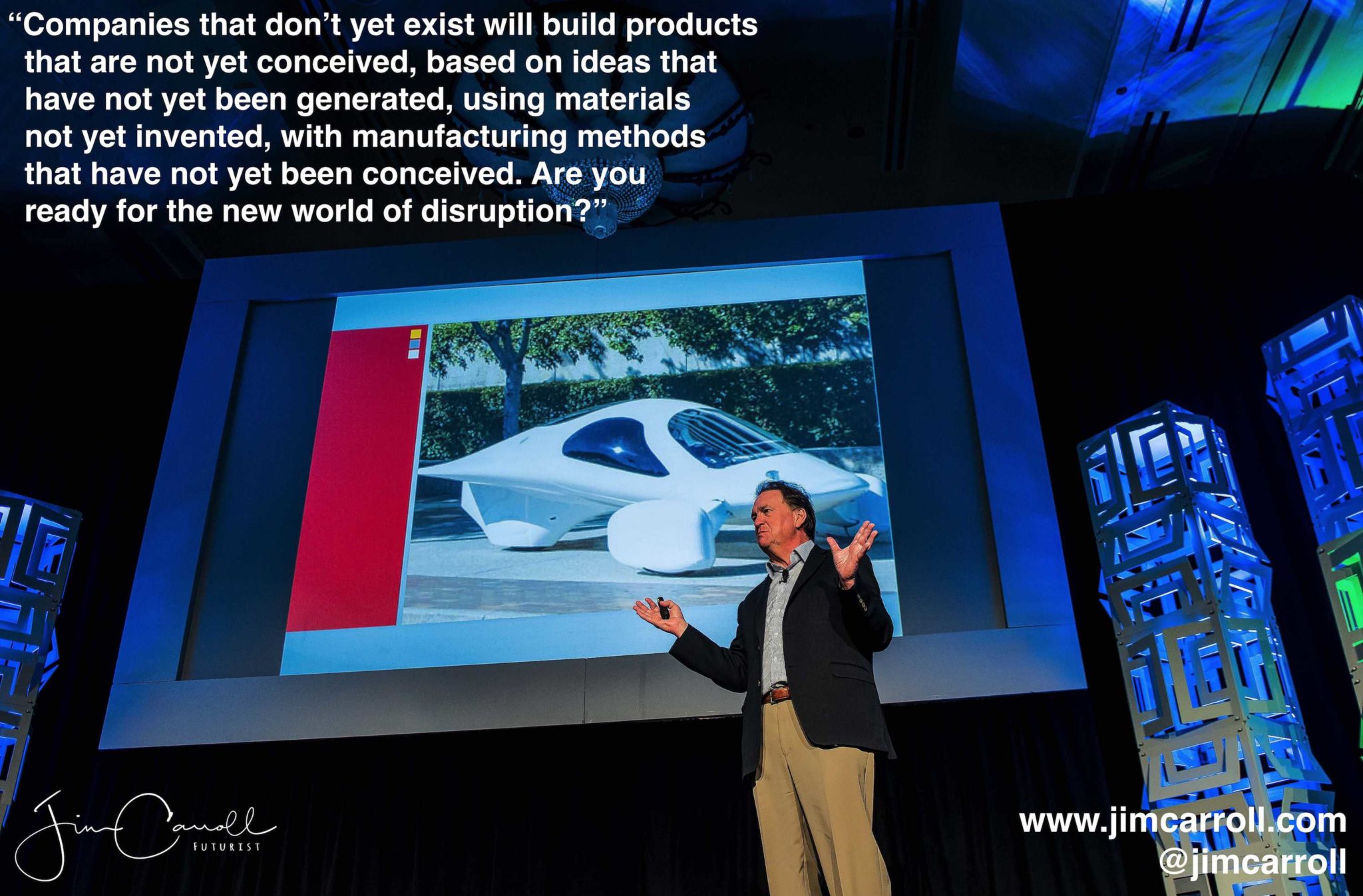
That reality is certainly proving to be true in almost every single industry. Now layer on top of that the potential for new risk. Something like:
“Risks that don’t yet exist will come from products, inventions and ideas that are not yet conceived, based on imaginative concepts not yet imagined…. Are you ready for the new world of risk?”
That’s the future of risk, and we’re living in that world right now.
There are a lot of different thoughts in this post; perhaps disjointed and not related. But they carry one common theme – we are seeing a lot of new risks and it is coming at us faster!
Accelerating Risk
For a long time, we have been living in a world of accelerating risk. Risk has been escalating, increasing and complexity, and has more far-reaching effects Yet in 2023, it’s pretty clear that new issues are simply going to come faster.
Consider the new issue of corporate reputational risk and the fact that many companies quickly pulled their advertising budgets from Twitter because they didn’t want their tweets to appear next to those of known neo-Nazis. Or the fact that the new owner seemed determined to make public previously private communications. No one really had these new risk issues on their ‘2022 risk management bingo card,’ but, here we are.
Now cast your mind forward to 2023 and beyond.
What might happen? Who knows – but we know it will be even more volatile, faster, and more far-reaching.
I’ve long been immersed in the issue of the future of risk. Since 1985 I’ve been reading Peter Newman’s Risks Digest, which is a global brain conductivity to all the people who are identifying new futuristic. A lot of what you read 40 years ago has become true today. Spend some time going through the archives, and you’ll find a lot of new unknown risks that became real risks pretty fast.
For a period of time in the late and mid-80s, the Risks Digest was my technology bible of choice. I did a lot of computer security work and saw firsthand what was emerging with complex new technology and connectivity issues – new forms of risk. Then, through the 90s and into the next decade, many of the books, magazines, and newspaper articles I wrote always included a pretty significant element of risk issues. Much of this obviously has to do with new computer and technology security and risk issues – and for quite some time I’ve been trying to alert organizations to the fact that the Board of Directors of companies and associations needs to be ultimately responsible for managing new, complex issues related to emerging risk.
Because if don’t have anyone bearing senior responsibility for management, technology, risk issues, and complexity of risk issues had accelerated incorporations you’ll get hurt. And that has proven to be true as we witness more organizations suffering from cyber-attacks and more.
Now going forward we have accelerating risk issues all around. Hyper-connectivity, more rapid technological change, unforeseen issues with social media with corporate takeovers (Elon Musk!), the impact of the crowd mentality, and in particular, artificial intelligence.
If you think you’ve been dealing with complex risk issues before, you haven’t, as the proverbial saying goes, seen anything yet.
What’s new?
- every new technology involves new risk
- we don’t fully understand the new risk that comes with this technology.
- we tend to roll out new technologies before we think through the implications of what risk it represents.
- people then discover this new risk, and take advantage of it, before we are prepared to deal with it
- we tend to get more excited about the opportunity of new technology than we do about the process of managing the risk that represents!
- we don’t really get any money allocated for the management of the risk with new technology at the same time that we spend money for that new technology
It’s the quintessential Pandora’s box!
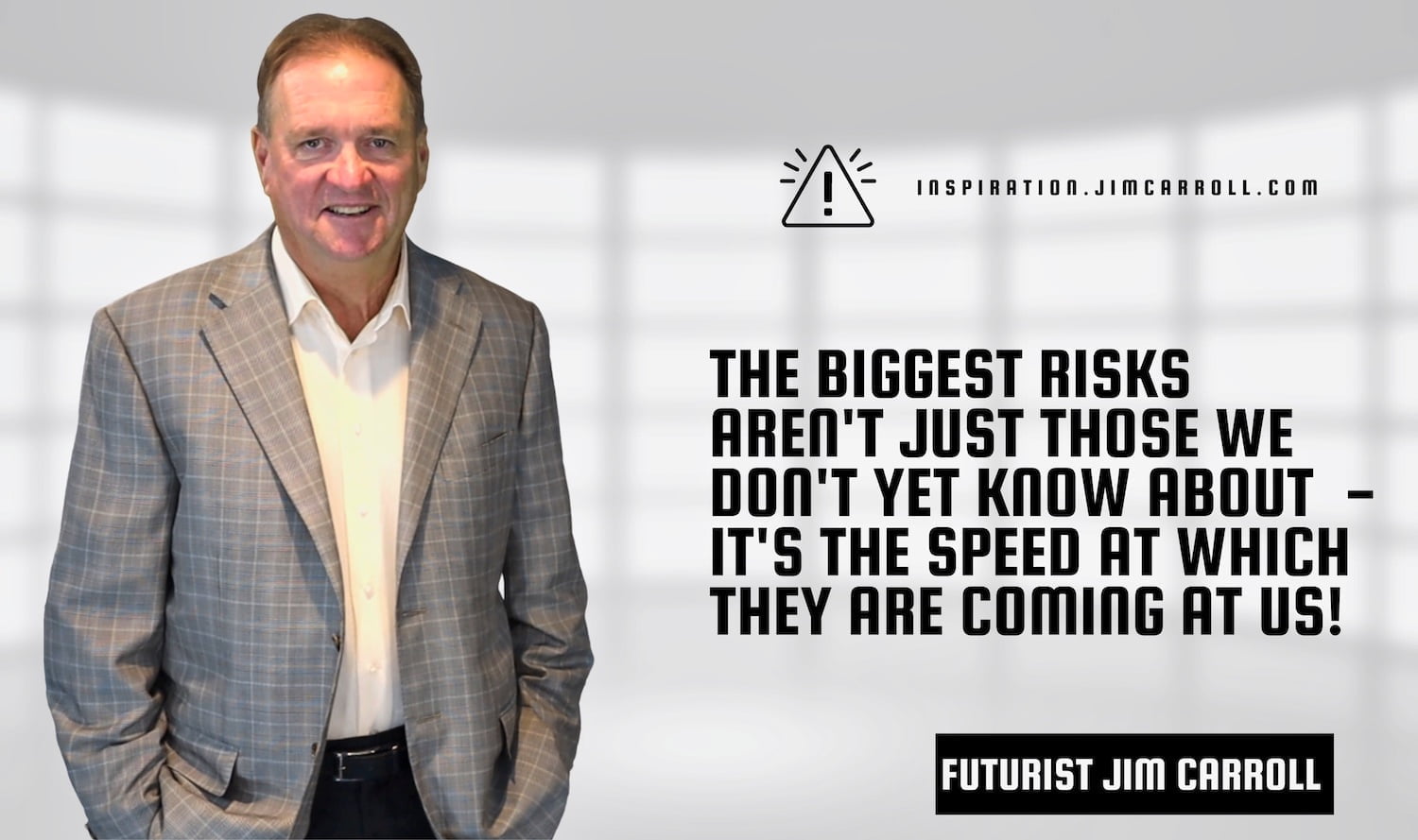
And the result is an ever-increasing gap between the pace at which new technology is implemented and the overall societal risk that it represents.
Nowhere is this happening faster right now than what is occurring with artificial intelligence technology, and specifically, what you are seeing with text-to-text and text-to-image AI systems? Ask a bot a question, and you’ll get a rather intelligent response.

How does the acceleration of a new risk happen?
Technology is inherently a risk-manufacturing tool New risk comes from several things:
- the speed at which new technology comes about
- the hyper-connectivity of this new technology with other new technologies – think about the Internet of Things!
- the pace at which people can now implement new technologies
- the speed with which one new technology can lead to other new technologies.
- the global hive mind and its ability to speed up the pace of the adoption or modification of this new technology.
- the impact of this new technology can have been combined with other new technologies.
- the connectivity that is driven by the Internet with this new technology, causing a cascading effect
- and the scope of the impact that new technology can have
The Impact of Unknown Risk
“You can’t minimize tomorrow’s risk with yesterday’s strategy!” – Futurist Jim Carroll
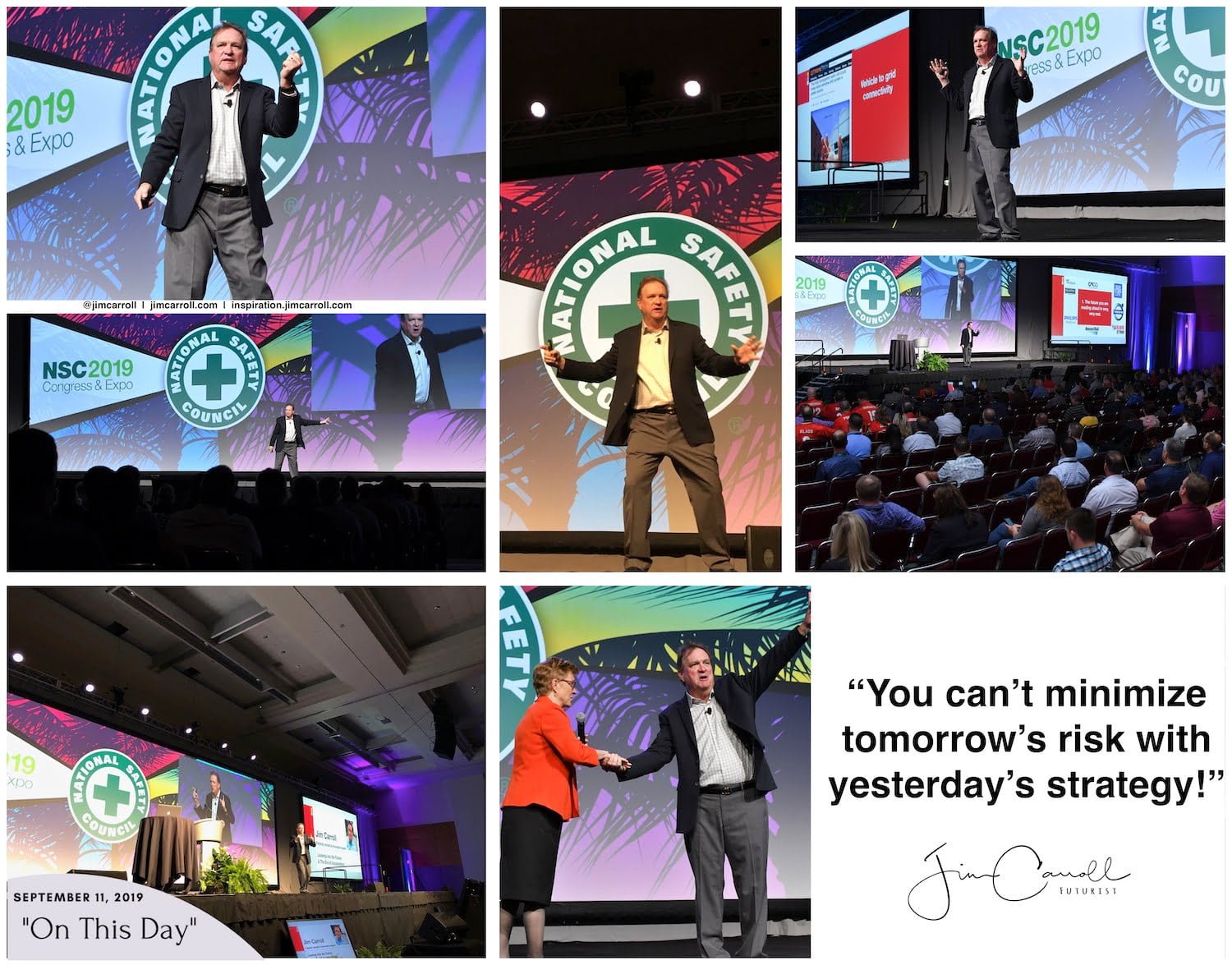
Back in 2019, I was invited to close the annual conference of the National Safety Council in San Diego. In just a few short months, their world of workplace safety risk would be consumed by Covid-19, and the concept of ‘workplace risk’ would enter a new and unknown world!
One of the key points I raised at that event was: the most critical risk you need to manage is the one you don’t yet know about! And in the era of acceleration, when the world around us is changing at the pace of exponentiation, it’s the unknown risks that will get us every time.
We can’t properly manage future risk if we don’t know what it is we are mitigating! Case in point – in the world of manufacturing, we might be busy preparing our facility to manage complex new safety issues. And yet at the same time, social distancing protocols are accelerating the adoption of robotic technology. And it’s the arrival and acceleration of specific cobot technology – cooperative robots ‘freed from the cage’ that work in close proximity to humans – that is really accelerating workspace risk. Is that on our risk horizon? Probably not – we’ll react to it, rather than be proactive.
To properly manage new risks, we need to have a clear understanding of the many trends that might impact our future, the speed with which they might become a part of our world, and potential strategies to minimize their impact. Yet, how can that be done when our every waking moment is trying to manage the massive volatility that comes with new technologies?
We do that by abandoning yesterday’s strategy, reinventing ourselves with a mindset that moves from a focus on today’s issues to thinking more about tomorrow’s reality.
New Legal Risk
Over the last few years, 3 of the world’s largest global legal firms have asked me for a talk on the new risks and challenges they are faced with in the era of acceleration. In addition, another one invited me for a similar talk in Dallas and Chicago for their major clients – a vast collection of chief legal officers from global Fortune 500 companies.
The challenge? Our new world of hyper-connectivity, driven by technology, the Internet of Things, accelerating science, and other issues is leading us quickly into a new world of unforeseen legal challenges. Somehow, we need to minimize our risk from legal issues which we do not yet know exist. That’s a pretty tall order. Just consider the issue of accelerated legal risk:
Here’s a quick little video I filmed that puts a concise perspective on these new challenges.
The acceleration of legal and other forms of new risk has been a component of my keynotes for several years – not just for legal firms, but for the many corporations and association events I speak at.
The acceleration of legal and other forms of new risk has been a component of my keynotes for several years – not just for legal firms, but for the many corporations and association events I speak at.
The challenge? Our new world of hyper change, driven by technology, the Internet of Things, accelerating science, and other issues is leading us quickly into a new world of unforeseen legal challenges. Somehow, we need to minimize our risk from legal issues which we do not yet know exist. That’s a pretty tall order.
How do you mitigate against risk when you don’t know what that risk might be? How do you guard against legal issues that don’t even yet exist? How do you guard intellectual property for products you don’t even yet know you will invent? That’s the challenging reality of our new world of risk today.
Want some fun? At one of these events, I put up a list of 40 new areas of legal risk management that did not exist 10 years ago. Protecting shared 3D printing models of your new products that could be easily counterfeited. Drone technology and surveillance law. Genetic counseling laws, LGBTQ issues, fantasy sports league management, organic certification, and laws involving cannabis use in the workplace and place of business.
That’s a short list. There’s lots more!
The Sad Ultimate Reality, of New Risk
“Every new technology is ultimately used for a nefarious purpose, accelerating societal risk” – Futurist Jim Carroll
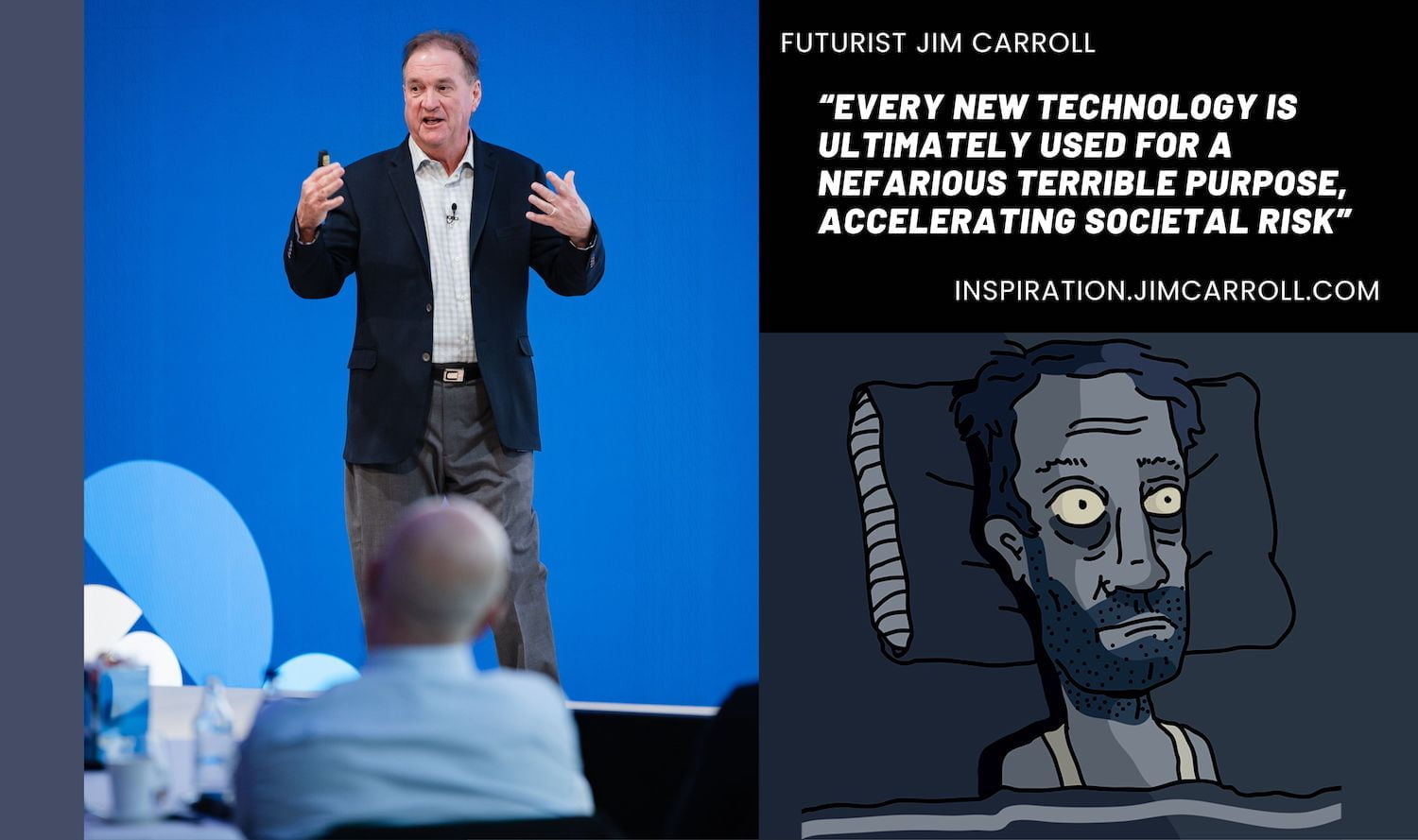
What keeps me up at night?
That was one of the questions that came to me with my recent keynote at the Zurich Global Risk Management Summit just a few months ago, held outside Lucerne, Switzerland. My main answer is, beyond the current geopolitical situation: accelerating technology.
This comes from someone who has been a huge technology fan since first getting online and into tech in a serious way in 1982. Why now? Because of acceleration – new technology is evolving so fast that we as a society no longer understand how to manage it and minimize the new risk that it presents.
That was one of my main observations for this audience of risk managers for global organizations – folks who have to monitor, manage and clean up after sudden new risk impacts their organization and society. To manage new risk, they must be able to identify and manage that new risk – but this becomes extremely challenging as that new tech matures at a pace that has simply become staggering. Bottom line? As I observed, while technology has always been a problem in terms of providing for new risks, the big problem now is the speed with which it is coming about.
“New technologies will now always emerge faster than the ability of organizations to manage the risk it represents!”
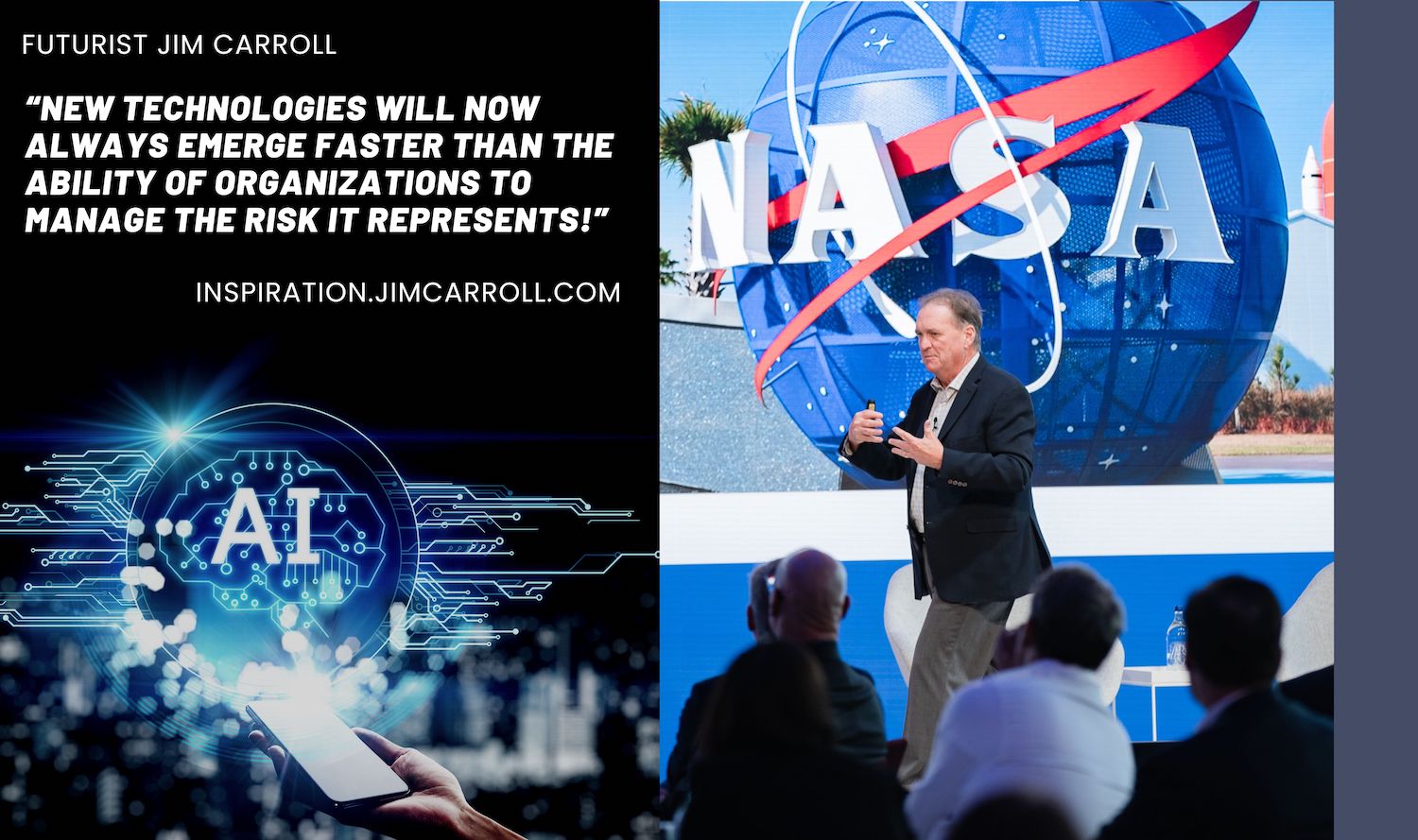
The audio of my keynote provides insight into the mindset I shared from the stage: our world is certainly quickly becoming an uncontrollable hellscape as immaturity comes to rule the agenda on many technology platforms.
I can go on Twitter and read my Twitter feed and in 20 minutes come away thoroughly depressed about the state of the world, because Twitter has been weaponized to a huge degree, and we have not gone through the thought process of how do we as a mature society deal with this rapid generation of false news and skewed news and a reality that does not exist. I don’t think as a society, we’re really having that conversation. I think from a corporate perspective, I think what we need to do is we need to elevate our concerns…
But the example I used in Switzerland had less to do with that and more with the broader trend of the speed of new risk. Take, for example, the acceleration of artificial intelligence – AI – and how quickly text-to-image technology was maturing. Listening to the audio transcript of my keynote:
Ultimately any technology which is coming out is going to present society and present you with unparalleled risks, and the challenge is now that new technologies will always now emerge faster than your ability to manage the risk it presents.
Specifically:
You will have seen in the last three months an explosion of news information on what we call text-to-image generators, artificial intelligence driven text to image and text to video systems. And what this is going to do is t blur the difference between reality and fake to such a degree that we will barely be able to comprehend it. That keeps me up at night a heck of a lot, and it comes from the same acceleration of technology that is providing disruptive opportunity,
This all leads us to a world of unknown risk – the ultimate challenge for today’s risk manager:
We’re now in a situation in which companies that do not yet exist will build products not yet conceived, using materials not yet invented with methodologies not yet in existence. How do you manage risk in that world? It means you need to accelerate yourself, you need to accelerate risk analysis, you need to have better radar on the trends that are coming with the future, both in terms of their transformative opportunity, but their massively disruptive downside.
During the Q&A that followed my keynote, someone asked me if we should worry about AI, Here was my answer.
I’m more concerned about the manner by which it can be used to alter reality, and what is going on right now with these systems, DALL-E and other text-to-image generators. It’s just exploded in the last three months, it sort of bubbled along there for years and years and years, and all of a sudden it’s… so massively real. What we can do with it is staggering, but what we can do with it from a risk perspective to generate fake headlines or generate video of politicians saying something that they never said, that’s coming at us extremely quickly. So I worry less about the role of artificial intelligence – you can do magical things, so for example, diagnosis of a disease, AI can do a better diagnosis of 909 different types of eye disease than an ophthalmologist …I’m less concerned about what it provides and more concerned about how it might be used or misused, and I don’t think we as a society are ready at all to deal with that reality.
The future of risk? Pretty complex!
Accelerating Reputational Risk?
Organizations spend a tremendous amount of money on their brand and their brand image. Reputational risk is a huge topic.
Years ago, I talked about the impact of social networking on brands: “a brand is no longer what you say it is. It’s what THEY say it is.” That’s the impact that Twitter and social networks have had on brands.
Now, suddenly in 2022 as the owner of a Tesla Model 3, I am wondering at what point my brand choice has gone from inspired to toxic! One fellow in Austin stuck a Mastodon sticker (a fast-emerging Twitter alternative) on this Model 3 to stays safe!
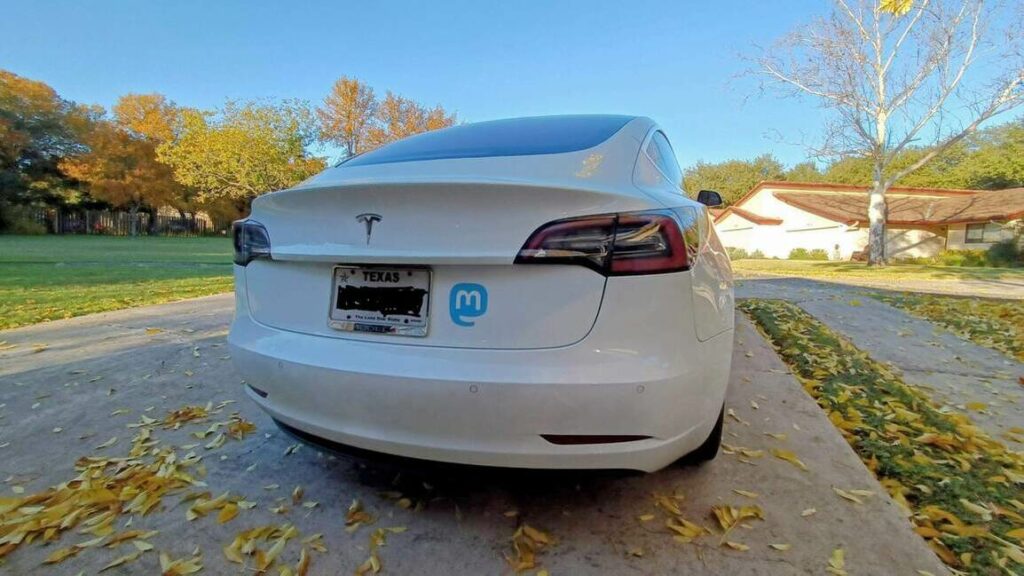
New reputational risk happens faster!
What Needs to be Done?
For over 20 years, I’ve been preaching that as long as corporate boards do not have specific responsibility for computer security and privacy in their skills matrix, the company will be at risk. I’ve tried to stress that ‘we are building this big complicated machine, and we don’t know how to properly secure it.’ And so a cartoon TV show can cause unwanted effects with in-home technology!
Yet it might not be that we don’t know how to secure it – it’s that we don’t bother trying! That trend will only accelerate into the next decade. I expect we will actually see a few Fortune 1000 companies disappear because of a massive security, or privacy breach, or because of some new technology trend that was not properly addressed.
Budgets don’t exist to properly secure corporate networks. The next generation of hyper-connectivity means that it is only going to get worse. Companies don’t pay proper attention to the issue. Most Boards of Directors have individuals who are experts at a narrow range of issues – executive compensation, legal, audit, and finance. FEW have Directors with detailed security expertise.
What’s to come? When companies don’t pay attention to security and privacy and technology and future risk, but the very essence of their existence is reliant upon the technology, the scope of a breach exponentiates. If a cartoon show can be used for nefarious activity, anything is possible. Watch the video above!
Self-driving cars will be hacked as will the intelligent highway infrastructure that supports them. Energy microgrids will be subjected to new risks as companies fail to secure distributed wind and solar energy stations. People will learn how to circumvent the new cashier-less stores, giving new meaning to the idea of ‘shoplifting.’ The list goes on and on …..
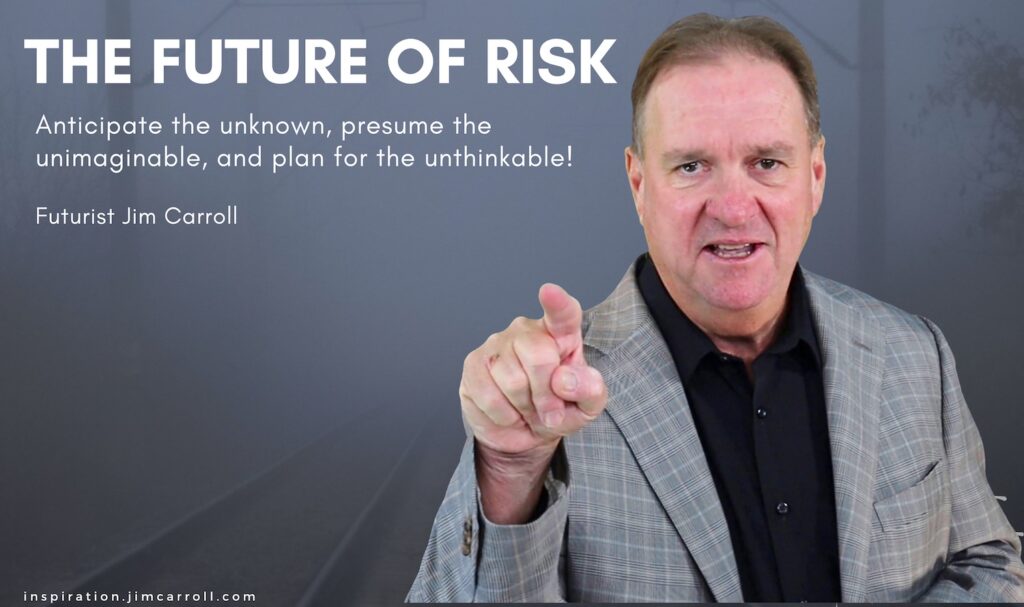
Watch this trend carefully – it’s going to continue unfolding with staggering implications.


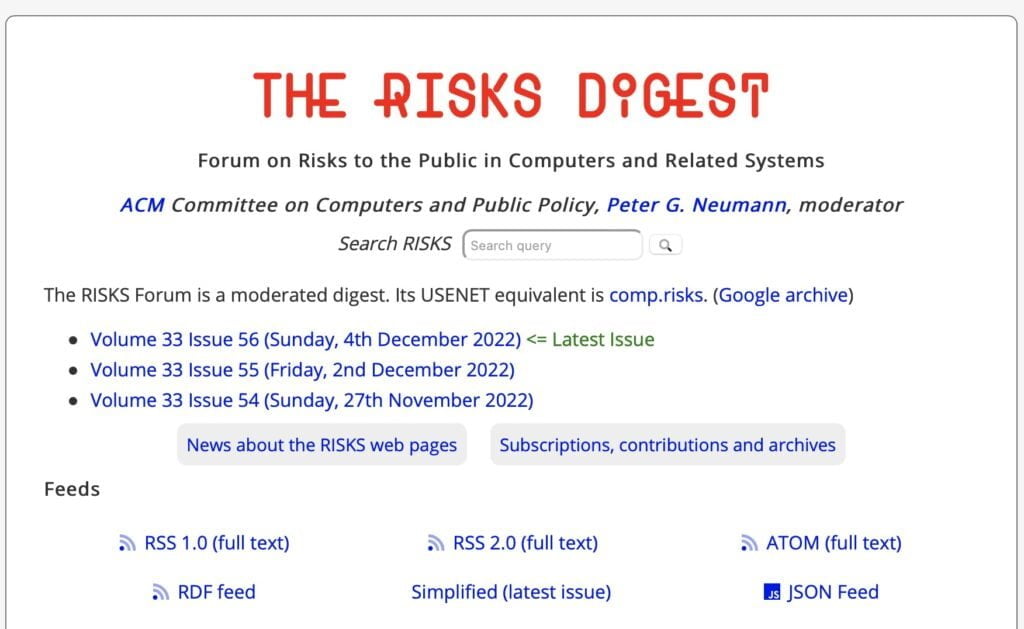


GET IN TOUCH
Jim's Facebook page
You'll find Jim's latest videos on Youtube
Mastodon. What's on Jim's mind? Check his feed!
LinkedIn - reach out to Jim for a professional connection!
Flickr! Get inspired! A massive archive of all of Jim's daily inspirational quotes!
Instagram - the home for Jim's motivational mind!